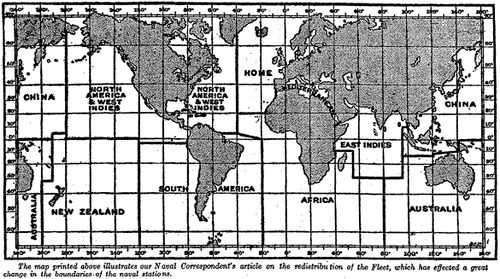Royal Navy
Administration
The Royal Navy and the Naval Service as a whole was directed by the Board of Admiralty, composed of a political appointee styled the First Lord of the Admiralty who represented the Navy in Cabinet and in Parliament. He was advised by a number of naval officers on the Board with variously defined briefs. The First Lord's chief adviser was the First Sea Lord (before 1904 known as the First Naval Lord) who was responsible for the fighting efficiency of the fleet. The Second Sea Lord (formerly Second Naval Lord) was responsible for personnel. The Third Sea Lord (also known as Controller of the Navy) was responsible for matériel. The Fourth Sea Lord (previously known as the Junior Naval Lord) was responsible for supplies. Quorum for the Board was two members, and it issued its directives through the Permanent Secretary of the Admiralty.
The "Admiralty" was a term which encompassed the Admiralty buildings in London housing the various departments which ran the Navy; the Department of the Secretary, the Hydrographic Department which mapped the world's oceans, the Naval Intelligence Department created in 1889, the Department of the Director of Naval Ordnance and Torpedoes, the Department of the Director of Naval Construction, the Department of the Engineer-in-Chief (the latter three formerly being in the Department of the Controller), the Department of the Medical Director-General, the Department of the Director of Transports, the Department of the Accountant-General, the Contract and Purchase Department, Victualling Department, the Office of the Admiral Superintendent of Naval Reserves (later the Office of the Admiral Commanding Coastguard and Reserves) and the Royal Marine Office.
The Naval Intelligence Department in the early years of the Twentieth Century effectively became a naval staff which advised the Board of Admiralty on dispositions and strategy. In 1911 this informal arrangement was replaced by the institution of the Admiralty War Staff under a Chief of the Staff which reported to the Board of Admiralty, but was still only advisory. In 1917 the staff became the Naval Staff and was given executive powers, the First Sea Lord becoming Chief of the Naval Staff, and two new appointments tasked with administering the Staff, the Deputy Chief of the Naval Staff and Assistant Chief of the Naval Staff, were given positions on the Board. Also in 1917 a Fifth Sea Lord was appointed to represent the Royal Naval Air Service, although with the creation of the Royal Air Force in 1918 this position was discontinued.
Fleets
At the end of the nineteenth century the main British fleet was in the Mediterranean, based on Malta. This fleet controlled the main contestable sea route to the Indian Empire. In Home waters was the Channel Squadron, as well as ships in reserve at the Home Ports. Smaller squadrons under Commanders-in-Chief were maintained on the North America and West Indies Station, the Cape of Good Hope Station, the China Station, Australia and the West Coast of America. In 1904 Admiral Sir John Fisher, one of the most prominent sailors in British history, claimed that, "Five keys lock up the world! Singapore. The Cape. Alexandria. Gibraltar. Dover."[2] All locations in British spheres of influence and control.
When Fisher became First Sea Lord at the end of 1904, a redistribution of the fleets began to concentrate ships in Home waters and to save money having ships on overseas stations. Battleships were removed from the China Station. A recently created South American squadron was disbanded. The Pacific Station had already been done away with. In 1903 a sea-going Home Fleet had been formed out of the reserves in addition to the Channel Squadron. In 1904 the former became the Channel Fleet and the latter became the Atlantic Fleet, both powerful battleship squadrons with attached cruiser squadrons. In 1907 a new Home Fleet was formed, composed of three divisions at the Home Ports. This squadron rapidly became the Royal Navy's main fleet. The Channel Fleet was absorbed into it in 1909, and the Atlantic Fleet in 1912.
In 1912, the Mediterranean Station lost its battleships, and the fleet in Home waters became the Home Fleets under one Commander-in-Chief. It was organised into three fleets. The First Fleet was composed of fully-manned warships. The Second and Third Fleets under a Vice-Admiral were composed of ships manned by nucleus crews which would be brought up to strength by active service ratings and reservists, respectively.
See Also
Footnotes
Bibliography
- Clowes, William Laird (1897). The Royal Navy: A History From the Earliest Times to the Present. Vol. VII. London: Sampson Low, Marston and Company.
- Kafka, Roger; Pepperburg, Roy L. (1946). Warships of the World—Victory Edition. Ithaca, NY: Cornell Maritime Press.
